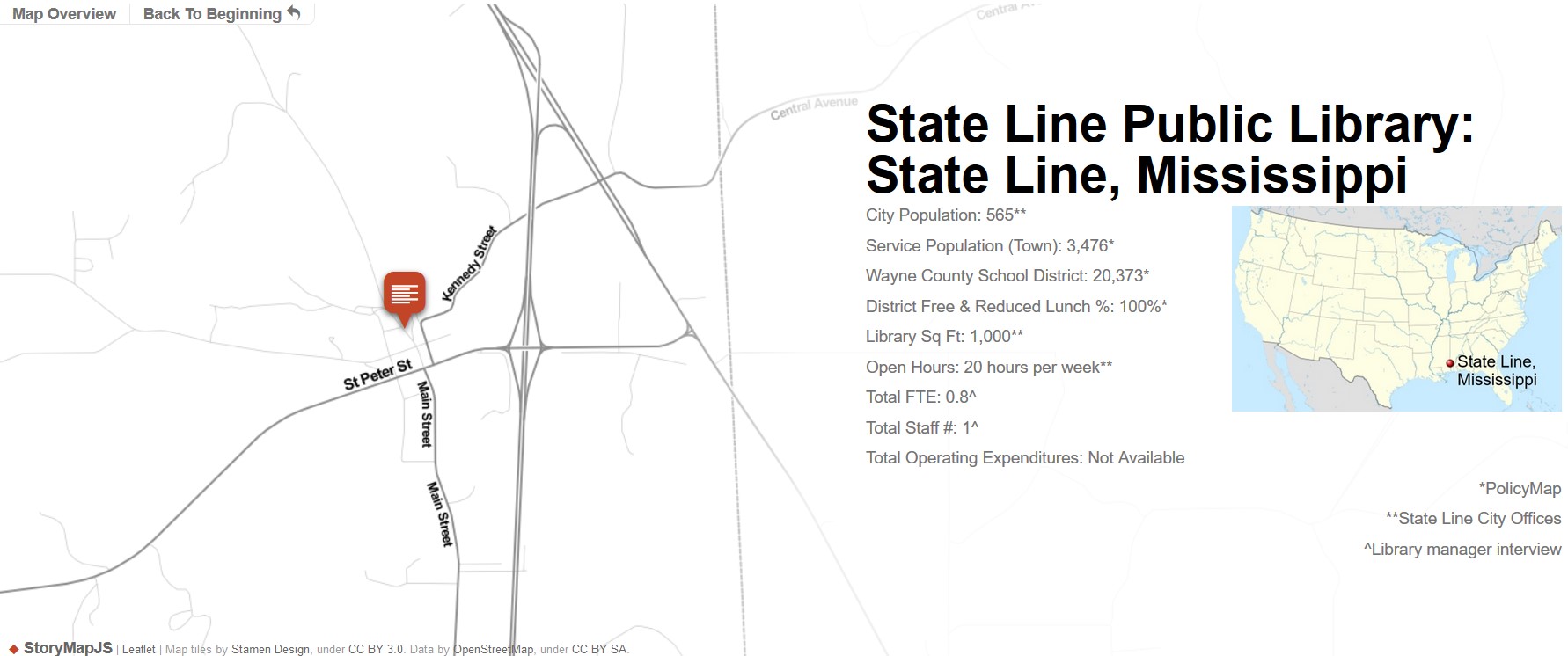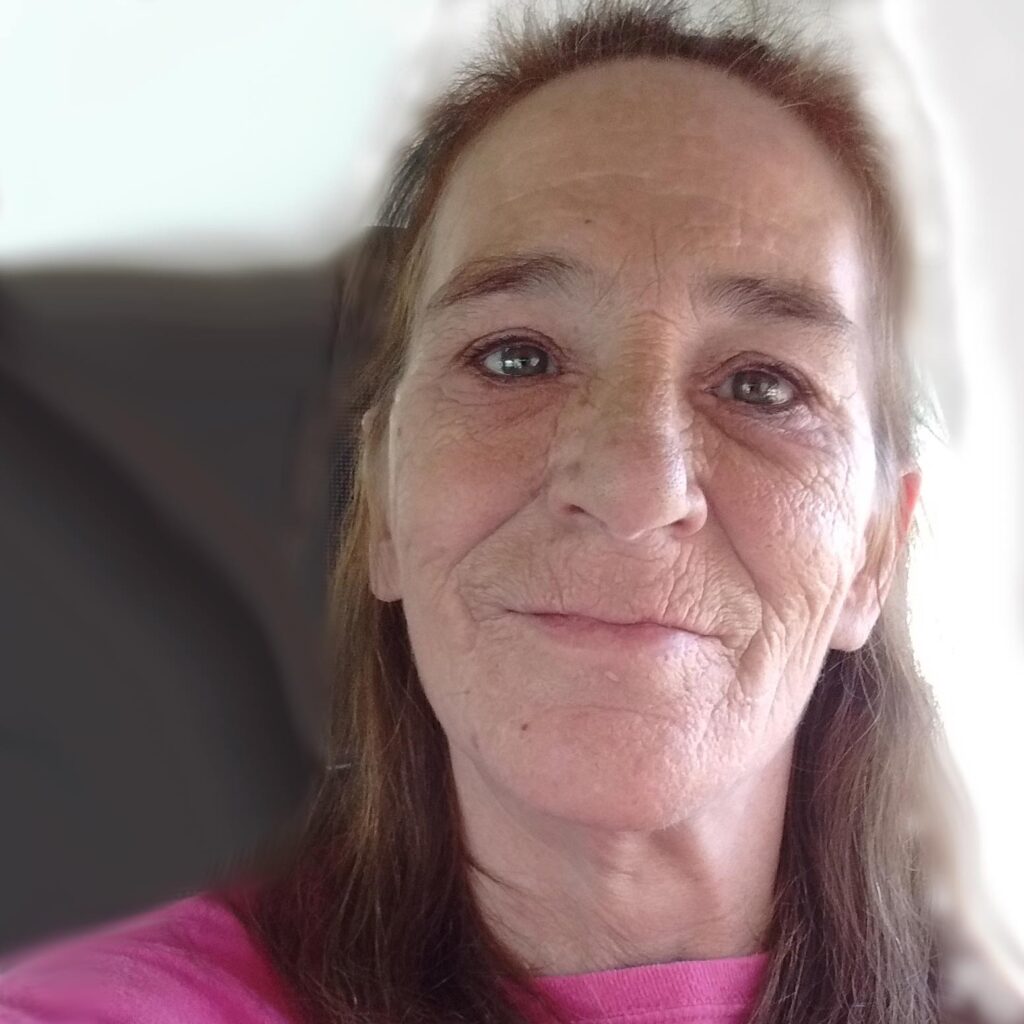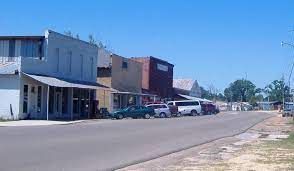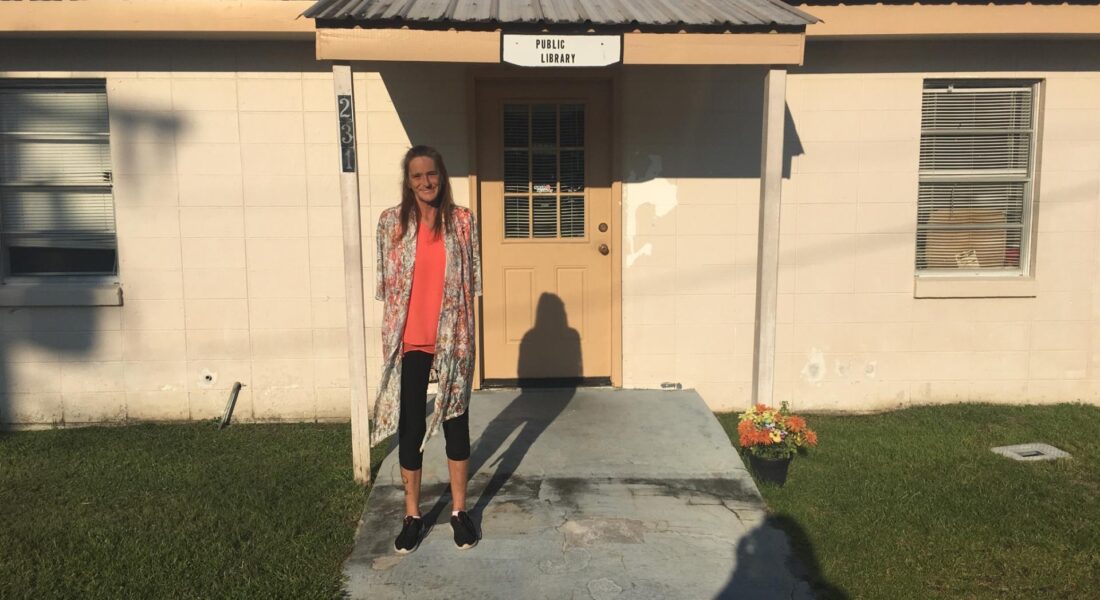
Pathways of Self-Determination toward Political Voice
Political voice is a dimension of social wellbeing and is included in most lists of core capabilities or social determinants of health indexes. Whether we feel we have a say in our own future within a community bears heavily on our motivation to contribute to that community – be it within an institution, neighborhood, or city. As demonstrated by sociologists, contribution and belonging are key to engagement in a social group, which is in turn key to our longevity and quality of life. Every small town resident has something to say about small town politics, but we witnessed places where the interplay between political voice & a living sense of community were evident.
How Self-Determination & Political Voice are evidenced in State Line
State Line is the only community library that isn’t independent – it’s a branch of the Pine Forest Regional Library. State Line has a divided dispersed sense geographically as well: it is split between Wayne & Greene counties, it is a walk from the border of Alabama, and although the city boundary is only a 2 mile by 2 mile square, the service region encompasses multiple census recognized population centers. It is very near the crossroads of state highway 42 and 57. Surrounded by dense forests, thick with vines, a photo might make it seem isolated—and indeed local residents often talk of it that way—but its location provides easy access to the nearby towns and big cities of two states.
Getting out of your car in State Line, Mississippi, you might lock the door out of habit, but you are likely to be told by a passing local that locks are unnecessary as crime is nonexistent. Looking around you will see a town with one of everything: a pharmacy, gas station, grocery store, bank, snow cone stand, barber, fire station, medical center, and just about anything else a person might need, running parallel to a central park. Residents of State Line often remark on the lack of businesses, the need to travel far to access services, or the lack of parks, but to an outsider, it sure appears that they have everything they need to thrive.
And the same is true for the people themselves: they possess an incredible diversity of experiences, talents, and knowledge. Many were born and raised here, many came through marriage, and some just found themselves here through the happenstance of life. It is not at all uncommon for residents of this area to have a blind spot for all that is good in State Line, focusing instead on all that could be better. But it is apparent that the problem they feel comes from wasted potential, not lack of potential.
State Line also has a library, but you may have to look hard for that. Until recently, the library was easily missed, a small nondescript sign on one end of a nondescript town building. Talking to town residents, many of them might tell you that until Pam Brown became the Branch Manager, they in fact were not aware that a public library was available to them. But Pam has not only made sure a sign now points the way—lacking a budget for such things, she was able to get a donation from a local sign maker—she has also made sure everyone knows the library exists and that she would be thrilled for them to use it.
Town coverage expands significantly beyond State Line city limits whose boundaries are only three by three miles. The town includes the outlying unincorporated communities of Knobtown and Eret, both of which lay in the two counties which split State Line down the middle: Green and Wayne. It is the firm belief of community residents interviewed that economic development requires a fair dose of government support. There is development in the State Line region but not within the city. Near Knobtown, six miles southwest of the city, new housing units are being developed along the newly constructed highway infrastructure. This might in part point to interwoven nature of tourism, connection to place, diversity of ownership, and economic development.
In State Line, residents repeated the claim that two families own nearly every property within the town lines and many people complained of an economy that is at best stagnate, at worst in decline. This abandonment of effort is seen in the ever smaller community events and general lack of government involvement in town improvements. Just outside, in Knobtown, the annual Knobtown Parade is the stuff of legend. Attended by thousands, it co-occurs with resident family reunions which retain and strengthen connection to place through generations. It is this connection that pulls people back to the region after seeking education and employment opportunities elsewhere.
It is hard to see why State Line would not be more popular as a home for more people. All of the basic economic necessities exist in the town: professional police department, grocery store, video rental, general stores, volunteer fire department, basic medical clinic, restaurant, and gas stations. It i’s in easy driving distance to employment opportunities in Alabama, where many residents interviewed work. It’s also closed to a robust agricultural network, and not terribly far from public schools for work. And yet, over the last eight years numerous businesses have left, following the elementary school which closed. Continuing the cycle of decline, the HeadStart closed and more businesses shuttered. No housing was placed on the market during those years and no new business has opened. The school sits abandoned and mired in the politics of the region. So although the town has many amenities, and is near major transportation arteries to major employment markets, it appears that if there is no major intervention, it may continue a slow downward slide.
In interviews, residents are indignant about the removal of the community’s only playground to build a parking lot for a new Head Start facility. As of March 2020 the HeadStart facility has not moved forward and the jumble of old playground equipment is heaped in the land behind the library, despite Pam being told it would be removed long ago.
Residents have a vision for what their home should look and feel like. They see that it is very nearly within their grasp, but seem powerless to take the actions needed to create the new reality. Some residents [EG2] seek out non-traditional paths to action, including building community coalitions which address school board or state government mechanisms directly, rather than working through local political mechanisms. These include a group of retired teachers interested in filing for charter school registration to be housed in the abandoned State Line elementary school.
Library as Facilitator of Self-Determination & Political Voice
Mississippi Library Commission (MLC) supports Pine Forest Regional Library System (PFRL) which in turn supports State Line Public Library as a branch. Given the level of local funding support for State Line Public it is unlikely that the community would be able to afford the library as a standalone independent entity. There are significant infrastructural needs that aren’t directly managed by either the town government or PFRL.[EG2] By policy, donations made to State Line Public are treated as income for PFRL, and do not necessarily benefit State Line directly. This fact is known by library supporters and likely diminishes their desire to donate.
Pam and community members both note that in a community with limited or isolated resources, having a public library becomes an important asset. It was common for residents to say things like “the library is the only thing we have” to describe the importance of investing in this last remaining public good.
Areas of service like local history preservation and access are not yet possible for State Line. In part, this service might be under-resourced by virtue of the library’s status as a branch rather than a standalone independent municipal library, as some residents suggest.
In State Line, the public library is the only remaining education institution and takes the responsibility seriously. The library leverages the limited resources it does have to increase educational opportunities for the community’s youth. Every public access computer is set to take kids to ABCMouse, as well as phonics supporting sites. Programming at State Line Public is designed to bridge the gap between fun and education in the most delightful ways Pam, can imagine. Pam, whose deep love of reading and literature is evident, designs weekly early literacy programs which support the growth of lifelong readers and learners through the love of storytelling.
Director as Path Builder

Pam Brown, branch manager for the State Line Public Library, has “never met a stranger”.
People interviewed were all library users and all big supporters of Pam. They shared stories and perspectives that equated Pam with the library in a one-to-one equivocal relationship. For instance, they considered materially supporting the library to be the same as supporting Pam. When community members here invoked the specter of need and funding in their interviews, they often framed it as a desire to help Pam to help the community. Their perspective that she was an essential “asset” in completing the community wellbeing puzzle was clear throughout the dozen interviews.
In State Line the current service agencies are the public library and the volunteer fire department. Pam is a vital contributor to and member of both. The community is also in the midst of a service transition with their local HeadStart which was closed several years ago. In response, Pam and her coalition of pro-community volunteers and change makers, hosted a volunteer run HeadStart in the library until the town board could identify an appropriate facility. Construction for the new HeadStart was imminent in fall 2019 during the field interviews and was top of mind, however the plans have since fallen through and the project is on hold indefinitely.
No mention of local functions was complete without talking about Pam’s role. Town board meetings, discussions of charter schools, National Honor Society functions, and elder outings for the homebound. Community-wide celebrations and regional food drives for homeless people – Pam was in the mix on all these activities. And had been since her arrival in town just over 5 years ago. Community members have stated a wish to reciprocate her support by forming a local Friends of State Line Public Library group to help with fundraising and organizing, although to date no action towards that has been taken, in part because of the awkward relationship with PFRL.
Driving her approach to leadership and service is empathy. Like most rural library director, isolation and poverty call on her to be resourceful, creative, helpful, and hardworking. Her uniqueness lies in her deep empathy with the community’s most in need residents and her vision for a hope filled future wherein they are able to accomplish their goals and experience delight in their lives. She appreciates the pleasures and escapes literacy affords and the relief one feels when someone truly cares for them.
Pam describes visiting the library before even the possibility of her working there as the moment when she “could breathe again” after an arduous move to a new place. At that time, neither Pam nor her husband had a car and they lived miles from the center of town. Pam would make her way to the library, to smell the books, to have reprieve, and to find herself in the world of print she had often turned to throughout her life. She repeatedly stated that her job as branch manager seemed to her a gift, one for which she shows her appreciation by providing consistently exemplary service to her community.
Conclusion
It is true that there is no sit-down restaurant in State Line, Mississippi, but the Snack Shack makes one of the best hamburgers you will ever eat. State Line is filled with talented, intelligent, motivated individuals. It is conveniently located, and has almost all of the amenities one could wish for in a town. The young people are polite in a way that you just do not often see anymore, and if you are new to town you will have made friends with your first trip to the grocery store. Despite its poverty and decline, State Line is a place of potential.
The library is seen as a primary information and action hub. It is seen by less active community members as a solace and home away from home–one where they are welcomed and cared for. If the library were to ever close it would be, as many described, a devastating blow. Not just to the core services and infrastructure it provides, but to hope for a brighter future.State Line Public Library’s branch manager, Pam Brown, works with community members to try make their ideal community a reality. [EG1] She represents, in many ways, the idea that by working together, with empathy and caring for each other, things will get better. Her selfless donation of time and money for the public good is done with great humility, a model for what needs to happen to unlock the great potential that State Line has. If you enter Pam’s library, you are an immediate friend, and for a town with many needs, this is priceless and irreplaceable.
Related Resources
Pathways of Lifelong Learning toward Self-determination: Case study from New Mexico
Self-determination tool: Building Local Political Voice & Power
Self-determination tool: Youth Empowerment
Self-determination tool: Preservation & Community Story
Branch Manager bio & contact information: Pam Brown
Listen and read interviews: State Line audio and transcript files on Open Science Framework
Article about Knobtown Parade 25th Anniversary: In Today In Mississippi


